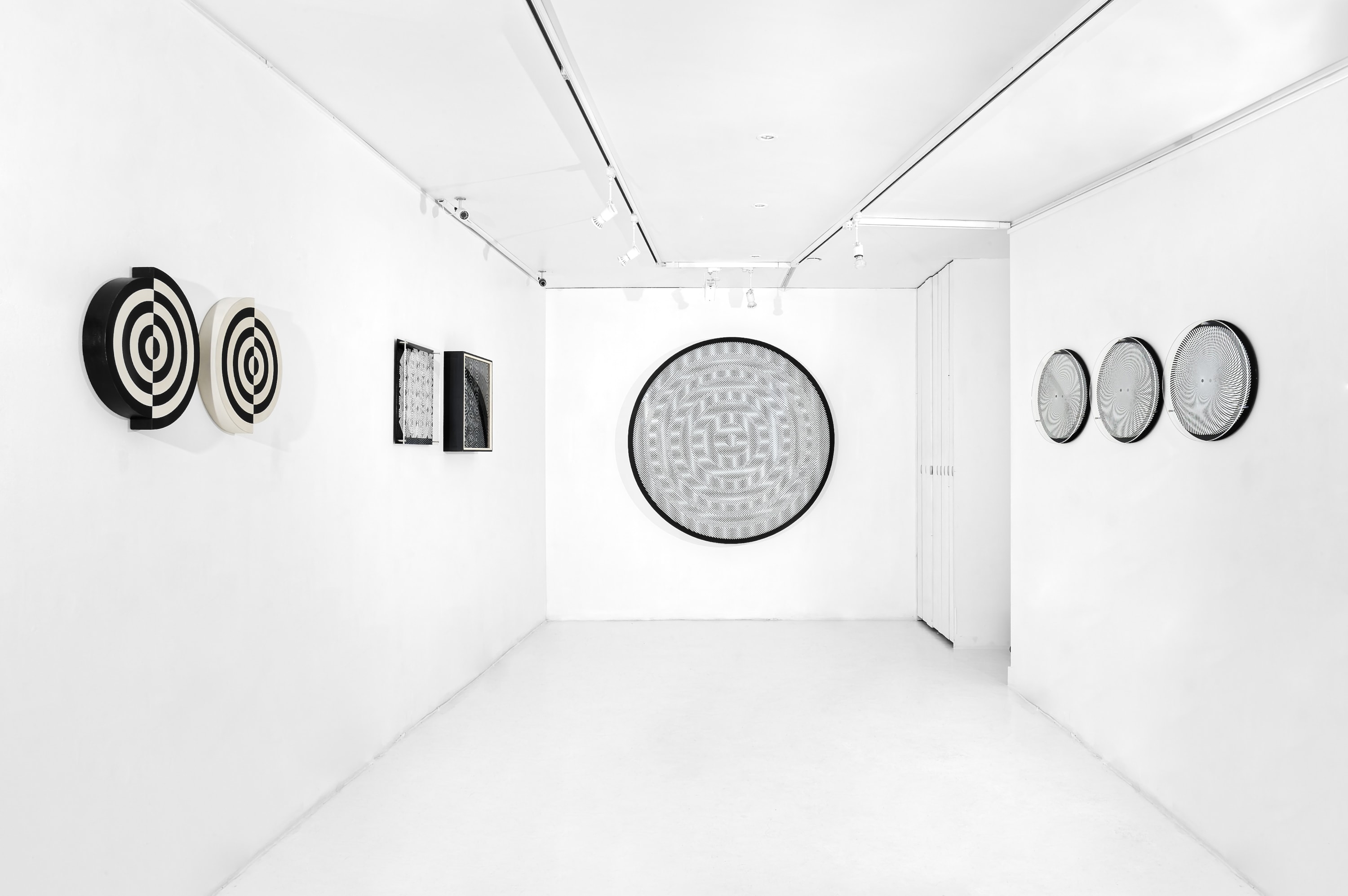-
-

-
Espace Meyer Zafra is pleased to dedicate to the Italian artist, Ennio Ludovico Chiggio, his first solo exhibition in France, Oscillations Dynamiques. From October 10 to November 30, 2024, the exhibition will bring together emblematic works of the artist from the 1960s to the 2000s.
-
-
The exhibition Oscillations Dynamiques explores experiments carried out by the artist from the 1960s to the 2010s. The term oscillation can be found in most of the works of the kinetic movement but is even more significant in the artistic work of Ennio Chiggio. By definition, an oscillation is a movement of a body that moves back and forth from a position of equilibrium. The central piece installed at the entrance to the gallery, Aeromach platonica BR (2008), perfectly demonstrates this interest in oscillation. Arranged around a fixed axis, the multiple polygons are set in motion, creating back and forth movements determined by the will of the viewer.
In 1959, together with several students from Padua, Ennio Chiggio founded Gruppo N (Ennio Chiggio, Giovanni Antonio Costa, Alberto Biasi, Manfredo Massironi, Edoardo Landi), one of the most important kinetic art groups, introducing the notions of object-works and open work theorized by Umberto Eco. Within this group, several collective works will be created. Informal gestures are overcome to adhere to more structured formal compositions in a constructivist sense with greater attention to the psychology of form (Gestalt theory). This notion was theorized by the Viennese philosopher Christian von Erhenfels in 1980. It explains that in the act of perception we do not just juxtapose a multitude of details, but perceive global forms that bring the elements together. We can find this notion in many of Chiggio’s works and more particularly in the works of the 1960s such as in the emblematic series of the artist Interferenze Lineari (e.g. Inteferenza Lineare 1, 1966-1977; Interferenza Lineare 0 - Quadradi + Cerchi, 1966) and Strutture Visive (e.g. Struttura Visiva - Anelli alternati margini mobili BN, 1964-1968) or in the work Dischi a rotazione apparente (1966).
-
 Photo: Louis Matray
Photo: Louis Matray -
Chiggio’s work is born from an intense dynamic of movements, from a kinesiology, in which lines, surfaces, directions, points of view alternate: real space is transformed into virtual space and vice versa. -Silvia Pegoraro
-
 Photo: Louis Matray
Photo: Louis Matray -
 Photo: Louis Matray
Photo: Louis Matray -
The period of the 60s is one of the richest in terms of research in the artistic work of Ennio Chiggio. In 1962, after many discussions with members of Gruppo N on the visibility problems of the program, Chiggio created the work Bispazio Instable for the group exhibition, Arte Programmata organized by Bruno Munari and Giorgio Soavi at the Olivetti headquarters (the prototype would also join the Olivetti collection). Two compartments filled with red and white spheres make up this work. Through the oscillation of the object, the quantity of spheres in the compartments constantly changes, and the two accumulations compose ever-different configurations, thus reflecting the artist’s interest in stochastic configurations. During the 1960s, Chiggio also experimented with sound research. In 1963, he met Teresa Rampazzi and began a collaboration that would focus on the study of sound. In 1964, at the 32nd Venice Biennale, Chiggio and Rampazzi presented the work Ambienti 1964. Several sound works were produced from this work, including Ronda Sonora, 1988.
As Roberto Masiero, architect and professor of architectural history, says: “In his travels, Ennio tests - that is, puts to the test - the many worlds of art and the always problematic boundaries between them.” Indeed, Ennio Chiggio was a multidisciplinary creator ; he was a visual artist, architect, musician, designer and graphic designer. Famous for his magnificent furniture, Chiggio never stopped creating. This is demonstrated by the Truchet/Cloud and Triferenze series, the first of which is based on Truchet tiles, used by many artists (such as François Morellet) for their combinatorial quality, and the second of which is based on prior research for the creation of the Interferenze Lineare.
-
 Photo: Louis Matray
Photo: Louis Matray -
Ennio L. Chiggio: Oscillations Dynamiques
Past viewing_room
















